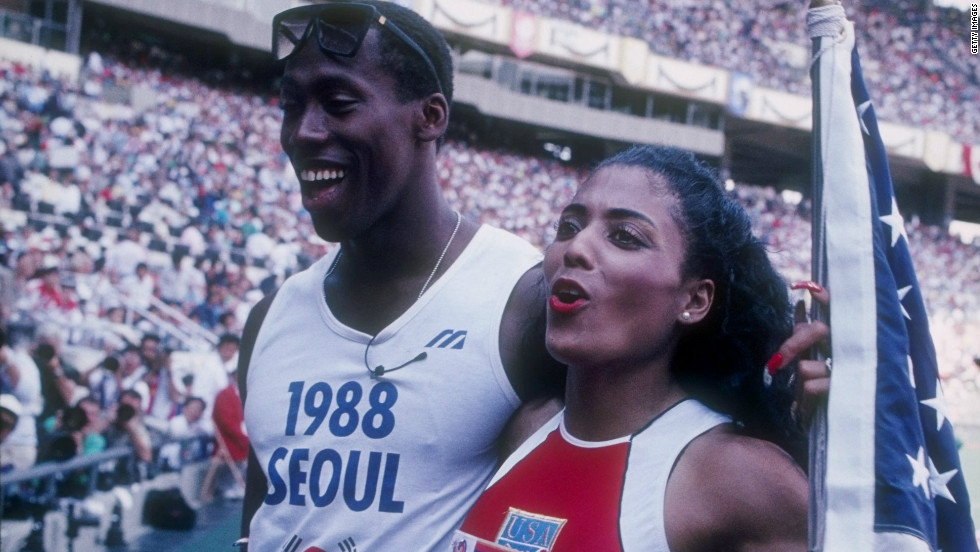Florence Griffith Joyner, known as “Flo Jo” is considered to be the fastest woman of all time. She was a superb sprinter who completely dominated the women’s track season in 1988.
Joyner, who was the seventh of 11 children, began racing when she was seven years old but had to give up sport at 19 in order to help support her family.
She was working as a bank teller by day and styled hair in the evenings when Sprint coach Bob Kersee discovered her and helped her enroll at U.C.L.A.
“I saw something I’ve never seen before in Indiana. I saw a sixth gear,” Coach Kersee said.
“I’ve never seen anyone with that speed and that fluidity. She’s wasting very little motion. There’s very little bounce in her stride. She and Jackie believe they can do the unbelievable.”
Four months later at the 1984 Olympic Games, in her hometown of Los Angeles, Joyner won 200m silver at the world championships in Rome, and she just kept on improving.
Before she travelled to Indiana, her personal best was 10.96 but in 15 months she transformed from an average sprinter to a taut world-beater.
She married Al Joyner, the 1984 triple jump Olympic champion and changed her name to Florence Griffith Joyner and eventually picked up the nickname “Flo jo.”
She was part of track royalty family. Her husband was a gold medal winner in the triple jump during the 1984 Olympics in Los Angeles. Her sister-in-law, Jackie Joyner-Kersee was also an all-time great in the heptathlon and long jump who won six Olympic medals.
At the U.S. Olympic Trials on 16th July 1988 Joyner achieved a spectacular breakthrough when she set two world records for 100m and 200 sprints; both still stand till today.

Flo Jo won gold in the 100m, the 200m and the 4x100m, and silver in the 4x400m. She ran the 100m in 10.49 and 10.54 seconds respectively, breaking the Olympic record twice.
In the 200m semi-finals she beat the world record by 0.15sec, and less than two hours later she beat it again in the final, by another 0.22sec.
The following day she won her semi-final in 10.70, and emerged victorious in the final, winning in 10.61. In 24 hours she had run the three fastest legal women’s 100m races in history, and before the trials finished she smashed the US 200m record as well.
In an era where runners were strictly advised not to wear long hair, jewelry or grow long nails, Flo Jo did the contrary and stood out. She reportedly had four-inch decorative nails; one-legged leotards: long, flowing hair which she carried with an extraordinary flair.
Her style inspired so many people in the field. After her retirement in 1989, she was commissioned by the Indiana Pacers to design their uniforms.

The designs were named “Flo-Jo’s” and are still an icon of the 90s basketball, reminiscent of Reggie Miller’s eight points in nine seconds and the team’s battles with the Knicks.
She was at a point accused of using banned substances. A former teammate even claimed he sold Griffith human growth hormone (HGH).
“In 1988, at the Seoul Olympics, I saw a side-by-side video of Flo-Jo from 1984 and that present time,” he said on NPR in 2013.
“She looked and sounded like a different person. The comparison was so shocking that the producer told me he feared it would be an ugly bombshell back in the USA, if such incriminating evidence were shown about an American heroine. So NBC shelved the tape,” Sports Illustrated Frank Deford who covered the 1988 Olympic Games told NPR in 2013.
Flo Jo was subjected to an arduous drug testing program before and after her Olympic meets in 1984 and 1988 and she passed every single test.
Alexandre de Mérode, the chairman of the IOC’s medical commission for 35 years, was resolute that Griffith was wrongfully targeted but in the end, no evidence whatsoever was found.
“We performed all possible and imaginable analyses on her. We never found anything. There should not be the slightest suspicion,” de Mérode said after the 1988 Olympics.
Her career as a top-level 100m runner was only three months and eight races long, but she still has all of the top three and five of the top 10 fastest times in history. Since then, not only does Joyner’s time still stand, nobody has even got close to it.
Joyner’s 200m record is also clearly unbeaten. The only person to have got within 0.30 of it since is Jones.
Flo Jo was regarded as one of the most incredible athletes in the world but it all came to an end too soon. She abruptly announced her retirement in February 1989, at the age of 29.
“I have decided to run on a different track and to strive for the best of which I am capable in a different field. Life has many things to offer all of us and, since the Olympics, many challenges and opportunities have been presented to me. I want to pursue them,” she said at a press conference.
According to the Guardian, in retirement, she designed clothes, wrote a couple of romance novels and a series of children’s books. She set up a cosmetics firm, recorded fitness videos, and turned her hand to acting.

A couple of years later she announced her intention to return to athletics. “I always had a love for distance running, and it’s been a dream of mine to compete in the Olympic marathon,” she said, setting her sights on the 1996 Atlanta Games.
“A lot of people will laugh about this, but you don’t laugh at Florence Griffith Joyner,” her husband said.
Florence Griffith Joyner could not compete in a marathon. In 1996, while on a flight from California to St Louis, she suffered a seizure. Two years later when Flo Jo was only 38 years old, she died suddenly in her sleep. She was said to have asphyxiated herself on her pillow during an epileptic seizure.
Even in death, her husband wanted to prove Joyner’s critics wrong and requested that her body be rigorously tested for signs of steroid use.
None was found. “My wife took the final, ultimate drug test,” Joyner said, “and it’s what we always said: there’s nothing there. So please, please, just let my wife rest in peace.”










